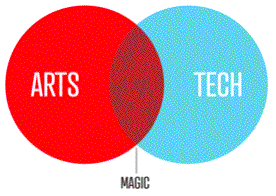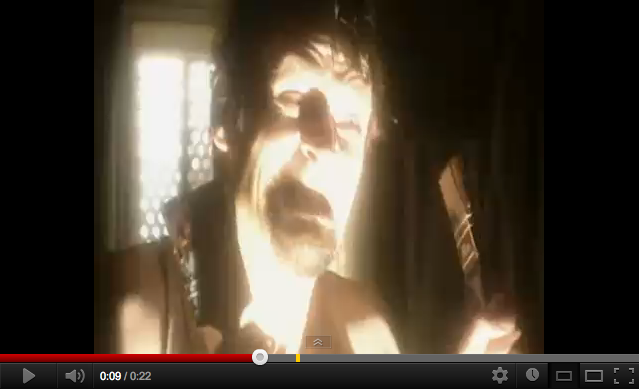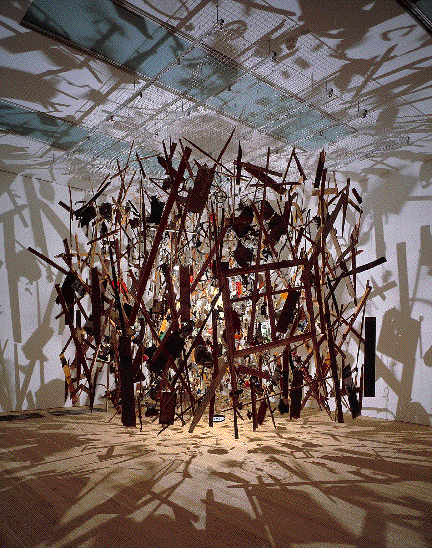Novi_sad + RYOICHI KUROKAWA performance, (2012) Usine C, ELEKTRA 2012, http://elektramontreal.ca/2012/#novi-sad-ryoichi-kurokawa-gr-jp. Clip by Megan Smith.
Accessed 11/05/12
ELEKTRA/ International Digital Arts Festival, in it’s 13th year, provides an exciting and critical platform for artists and institutions. This years expansion to an International Digital Arts Biennial (BIAN) is a positive and logical step forward for this mature festival. While the cross over between the two events was at times confusing, I see it as a learning curve for the organisers and anticipate that in 2014 they will have a more solid understanding of how ELEKTRA and the BIAN fit together. Over all, this is a festival that is not to be missed. ELEKTRA is already a significant contributor to the creative sector and with the addition of the BIAN this event is on it’s way to becoming very competitively placed for pushing new ground within the Arts and Technology.
Through delivering the ‘International MarketPlace for Digital Arts’, an intimate presentation program that showcases a combination of it’s featured and invited artists to speak alongside, and at par, with galleries, curators and creative institutions from around the world, ELEKTRA set’s the bar for fostering new partnerships. Furthermore, it pushed the discussion on practice-based research ahead in a democratic manner by placing equal importance with the developer and producer within one information space. This was a highlight of the festival and must have been of real benefit to both groups as they found future partners and allies. The casualness of these talks also candidly offered up some interesting information and local reactions to European budgets and infrastructure, a few insights are tweeted by @serial_consign below.
Screen grab from @serial_consign‘s twitter stream 05/10/12.
The free ticket admission to the 2-day ‘MarketPlace’ also deserves applause, as the ability to access and mingle with the speakers provides an open and inclusive opportunity for the community of Montreal and for those from beyond the city to interact with a group of movers and shakers in the creative sector. The over arching theme of this event was met – to form new collaborations.
In fact, having attended the innovative Manchester-based, FutureEverthing conference over a number of years, I think ELEKTRA’s ‘MarketPlace’ model would be a major benefit to FutureEverything’s program. From a personal perspective, because it fills a social gap between the digital artists attending the event and the producers looking for new collaborators, it enables a constructive workspace amongst a concentrated number of creative thinkers.
The second highlight was the electronic music. This component of the program was incredible and on several occasions I was captivated by the combination of visual and audio experience offered. This was a very sophisticated area of the program that also openly addressed politics. I was challenged and importantly I was pushed to try to decipher the data presented, and to question how the composers behind these pieces develop and execute their technical and creative process. While the first evening’s performances were intriguing it was the Alva Noto (aka Carsten Nicolai) performance ‘UNIVRS’, at Musée d’art contemporain de Montréal, which worked it’s magic for me. Furthermore, compared to the other events, in this one I could at my own will move around the space during the performance.
‘UNIVRS’, (2012) Alva Noto (Carsten Nicolai), at Musée d’art contemporain de Montréal. Clip by Megan Smith. Accessed 11/05/12
Jean Pierre Aubé’s performance ‘TXL.IST.BOM.HKG.SFO+YUL’ generated from his ‘Electrosmog World Tour‘ and hosted at Centre Clark was the most accessible. Without pretence or dramatic special effects his tools and his process were made public. In fact, it was the visibility of his process that has left me feeling like his was one of the most rewarding experiences during ELEKTRA, and it has made me question the theme of the entire program – ‘the INVISIBLE,’ or the ‘PHENOMENA’, depending on whether you read the BIAN editorial or the ELEKTRA one.
While technology is seeping into most aspects of Western daily life some devices and projects are most successful when their interfaces are said to disappear or become an immersive experience, which is a state that is sometimes mistakenly understood as being invisible but is most definitely becoming phenomena. I don’t believe that this experience is associated with the most innovative or the ‘cutting-edge’ within the arts. Instead, I feel that it is the makers, hackers and thinkers who are actively revealing and un-picking world data who are carving out the next genre of art making and are helping society to understand and develop the new aesthetic; their process is one that can be observed and engaged with.
Furthermore, it is what is no longer hidden from view, and that which can be detected that is activating imaginations world wide to reveal truths free from the need for dramatic agency. Within this context, Aubé’s geopolitical sound score stole my critical heart, it excited me and made me curious. He did this by laying his process bare, by inviting his audience into his production space, by eliminating any illusions between his audience experience and the technicality of producing his work. Essentially, his work enmeshes art and technology and it renders a human story, and that is wherein lies the magic.
Image sourced from the CreativeMornings June theme The Intersection of Arts + Technology. http://www.creativemornings.com/ Accessed 10/05/12.
While the crossing of disciplines is age old, increased access to information via the internet and new and open-source technologies has enabled a boost for the areas of science and technology to exchange with the arts and vice versa. The partnering of these two fields is worthy of the title of phenomena because at their intersection are works that are changing the status quo. ELEKTRA tried to feature some of these pieces within their digital arts programming. While the gamut of installations and robotic immersive experiences were sophisticated, beautiful and intriguing I was confused about why in the current colourful and complex state of digital consumption I was repeatedly forced into a pitch-black space to see the curated works?
‘DSM-VI’, (2012) Bill Vorn, Hexagram-Concordia. Clip by Megan Smith. Accessed 11/05/12
Furthermore, I was concerned with the overarching sense of doom associated with the curated program. After seeing Bill Vorn’s ‘DSM-VI’ I could not help but think about the episode in ‘Spaced’ (by Simon Pegg & Jessica Stevenson) when Brian says he is an artist and Daisy responds by asking ‘What kind of thing do you do?’ … http://youtu.be/BvYXamcNwRQ. His response mocks the bygone ‘oh so serious!’ art world with the response of anger, pain, fear and aggression.
Screen grab from youtube clip http://youtu.be/BvYXamcNwRQ Accessed 10/05/12.
The black space immersion and foreboding, bordering on depression, continued with ‘Fragmentation’ at the Montreal Museum of Fine Arts where scenes from a Robert Lepage piece are pushed onto the Reactor, a 3D projection system designed by Sarah Kenderdine and Jeffrey Shaw. The system itself is really interesting, once your eyes adjust and you can see it, and it made me wonder if perhaps a partnership with Ubisoft would be an avenue worth exploring in terms testing 3D capabilities with some cutting edge visual content.
‘Tripwire’, (2012) Ashley Fure & Jean-Michel Albert, Ancienne Ecole des Beaux-Arts de Montreal. Clip by Megan Smith. Accessed 11/05/12
‘Out of the Blue/Into the Black’- the group show at the Ancienne Ecole des Beaux-Arts also imposed almost total black out. Why? While ‘Tripwire’, by Ashley Fure and Jean-Michel Albert is a fantastic experience of sound, image and subtle participant interaction, and I can see how the darkness makes this piece come alive, several of the other installations could have been experienced within a light space. Olivier Ratsi’s ‘White roads in the red matrix’ could have been far more dramatic with a light source added to the space which allowed the viewer to walk around the piece comfortably and to investigate its elements. This is the successful trick that Cornelia Parker’s ‘Cold, Dark Matter: An Exploded View’ (1991) holds over her visitors.
‘White roads in the red matrix’, (2012), Olivier Ratsi, video clip by Megan Smith.
‘Cold, Dark Matter: An Exploded View’ (1991) Cornelia Parker, image sourced from/
http://www.tate.org.uk/art/artworks/parker-cold-dark-matter-an-exploded-view-t06949
(Accessed 10/05/12)
The artist James Turrell’s has been pushing the limits of immersive light installation for decades and while ELEKTRA was wise to showcase light pieces that include sound and network capabilities, the simplicity of experiencing Turrell’s work plays an important part in transforming the ordinary. Once accessibility to their work is achieved, then the new digital artists can expand the cultural dialogue that they chose. An example of a Canadian artist who is working within the intersection of art and tech while developing accessible and magical experiences is Steve Bishop. In particular his piece ‘Suspension of Disbelief’ (2007) is worthy of attention in the context of this program. He still tells a doomed tale, though in daylight, and maybe that is just what makes it that little bit more frightening.
Finally to add to the dark and doom, paranoia showed it’s face during the Syncretic Transcoding conference run by the BIAN, when the artist Marie Sester suggested that social media may actually be a ‘fake communication system’ and that ‘…through our repetitive use and addictive tendencies towards new technologies we are loosing the ability to understand and to read our own bodies.’ She purposed that …’the human body is like a machine and that this addiction is impeding our ability to sense; an act that obstructs our ability to recognize our own anxiety’. She then said, ‘…Being real is simple. It’s just being where we are’.
I say – Are we all so serious that we have to experience disaster in a pitch-black space, then listen to sound while not moving a muscle?
Can we not work with these technologies without forcing people to trip over each other in a dark room?
I heard one woman at the Museum of Fine Art, aggressively scream at her husband from the entrance of the LePage installation. ‘Forget it, I can’t see a thing, I’m leaving!’
What ELEKTRA has left me with is a sense of warning. New media can be harnessed by creatives and technologists and then pushed to new potential, but overall I’m uncomfortable, in some instances, with using it to produce aggressive works. The world is volatile and I feel the artists role within this situation is to reveal truths and to decode data in order for the public to see it in new ways. If we relay aggression in our work we may perpetuate existing problems and ultimately have difficulty with accessibility to our work.
Part of the magic of 2012 is that several producers, developers, curators within the digital arts and new media practice are trying to be transparent. Not only do these people want to learn, they also want to step beyond the passive experience. They want to get their hands dirty, to test, to make, and to do. The orchestration of ‘Cinetose’, a major installation within the ELEKTRA program, was managed by what looked like a series of technicians semi-disguised behind a booth within the installation space. When in full throttle the audience is immersed in pitch black shattered occasionally by strobe and search lights then the ceiling aggressively starts banging and starts to descended and retract in sections while the audience lets out nervous chuckles (X 30 minutes). This is the kind of experience amusement parks do really well, they threaten their audiences while the participants know that they are relatively safe. In the arts I expect more, I wanted to get behind the scenes of ‘Cinetose’ and push the buttons, to commission a series of musicians to play with the installation, and above all I wanted the light on as that beast descended on me. I don’t want to be securely invisible and drawn in by an immersive tale, I want to risk being open.
‘Cinetose’, (2012) Projet EVA, Usine C, Clip by Megan Smith.
As I look forward to what ELEKTRA and the BIAN will offer in the future I have these questions for my own practice and I share them as possible strands to explore.
- Questioning our relationship with technology- should the experience be more formative by opening up the system for the participants or audience to take part?
- Now that we have figured out how to hack technologies and to master others in the pursuit of a specific aesthetic, how can we apply our skills and our talents to push the limits of transparency?
- If robotic technologies are now at the ready for a growing number of creative individuals and partnerships to use, if we can now program and hack the pixel, how can we use these technologies to play a little more and to share more?
- How can we use data from the web to decipher and to bring light to problems, solutions and to social change?
- How can we collaborate more and become more accessible artists, is this through enabling audiences to workshop, hosting public labs, or sharing our tools and experiences?
Finally, instead of perpetuating the mystique and drama of a theatrical performance and forcing an audience to sit obediently in the pitch black to observe, I think we should challenge the exhibition format by learning from accessible and playful pieces like ‘21 Balancoirs’ by Mouna Andraos and Melissa Mongiat, and we should press on for more projects like ‘Parcours Numérique’, which showcases projected and interactive pieces on the façades of buildings in Montreal. We don’t necessarily need to build a new creative infrastructure to address the invisible phenomena we just need to participate and engage with what we have.
It boils down to this. I don’t want to be administered magic in the dark. I want to turn the light on and become immersed.
By: Megan Smith
Tags: AV, digital arts, Elektra, Festival, Field Trip, installation, Montréal




I really like ‘Cold Dark Matter’ but the rest does nothing for me – sorry.